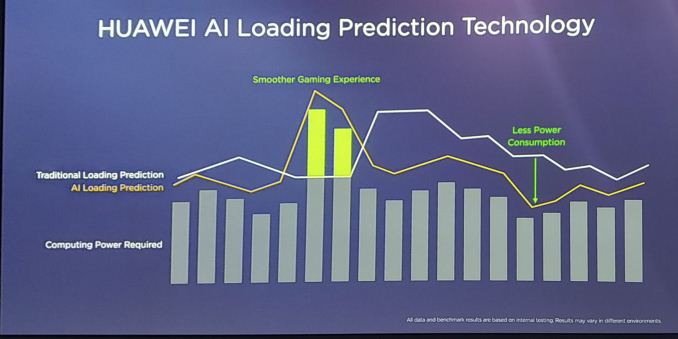Huawei’s GPU Turbo: Valid Technology with Overzealous Marketing
by Ian Cutress & Andrei Frumusanu on September 4, 2018 9:00 AM EST- Posted in
- Smartphones
- Huawei
- Mobile
- Benchmarks
- honor
- Neural Networks
- Kirin 970
- AI
The Claimed Benefits of GPU Turbo: Huawei’s Figures
Some of the most popular and widely quoted figures from the marketing slides during the release of GPU Turbo were the claims that the new feature would somehow achieve both up to 60% higher performance while also being able to reduce SoC power by up to 30%. Huawei (and Honor) are very very keen on these numbers, and show the results in the best possible light.
These figures were so widespread that they were again reiterated in last Thursday’s IFA global launch of the Honor Play. Over the last few days, I’ve seen plenty publications reporting these figures and attributing them to the benefits of GPU Turbo. However as of yet, no analysis has taken place.
Most slides we have seen look something like this, making it very easy to just put numbers into an article:
As AnandTech is very much a technical-oriented publication, from the get-go these numbers looked suspicious to us. We take pride and value in our own independent analysis, making sure that the numbers promoted are remotely achievable. After all, numbers like this often go against common-sense engineering advancements. And this is exactly where the marketing numbers fall apart. More on that later.
So What is GPU Turbo? We Finally Have Some Clarity
When we initially went looking for a detailed explanation of GPU Turbo, I (Andrei) first attempted to figure out by myself what GPU Turbo does. The lack of details, aside from projected performance improvements, is a very weak place to start. It also ended up being quite a nightmare of a task for one specific reason: despite years of allowing devices to be rooted, at around the same time as GPU Turbo was launched, Huawei and Honor stopped allowing bootloader unlocking. This prevented users from modifying the system’s firmware, and us included as we were unable to root the devices to help with benchmark profiling. Furthermore, all new firmware that ships with GPU Turbo is said to be vastly more locked down. It has not been made clear if the two items are directly related, though anyone who likes a good conspiracy might be inclined to think so.
As a result, in the context of GPU Turbo, what I had in mind was to actually profile the GPU via Arm’s Streamline tool, as this would give us exact information on the workloads that the GPU is processing. With these tools, we can deeply analyze what is going on under the hood. Either intentionally or unintentionally, the lockdown of the bootloader prevents us from doing this. Unfortunately because of the limitations, this was a dead-end in my testing.
I had started writing this article with no further detailed explanation, however we met with the EMUI software team at IFA, and we were able to finally get a more comprehensive explanation as to what GPU Turbo is. We discussed this technology with both the hardware and software teams, and had very different discussions with both.
With the hardware team – specifically with HiSilicon – they made it clear that this is purely a software technology. The mechanisms in GPU Turbo are aided by the controls they put in place, but the actual way that GPU Turbo works is all down to software. This is good to know, and also explains why Huawei is able to roll it out across all of its smartphone range. It also is not tied to the NPU, although having an NPU in the mix does help, apparently.
However, the public first hint of what it actually does was included in Friday’s Kirin 980 keynote presentation, referred to as “AI Loading Prediction Technology”.
What the slide tries to convey is that GPU Turbo allows the SoC to better follow the compute workload, adjusting the hardware performance states in order to better adapt to the workload. For example, when the CPU needs more power than the GPU, the power ratio availability can be adjusted to match these new requirements, improving both performance and efficiency.
We go into a bit more depth on the next page, where we finally have a good explanation of the mechanism. We have to thank Dr. Wang Chenglu, Huawei’s President of CBG (Smartphone) Software, for this information.













64 Comments
View All Comments
mikael.skytter - Monday, September 10, 2018 - link
Hello!Problem on Page 5. There is a large video between the buttons comparing phones and the picture that displays the different phones in PUBG.
Thanks!
/Mikael
Ethos Evoss - Wednesday, September 26, 2018 - link
I just got Huawei Honor Note10 and it has turbo .. :) BEST smartpohne everSuraj tiwari - Thursday, January 31, 2019 - link
Even powervr gpus' r better than mali gpus'. I was surprised when samsung didn't buy powerver but soon realised that bcz they have long contract with ARM & Mali gpus' r cheapannasansers12 - Thursday, April 25, 2019 - link
Huawei's latest feature which is the GPU Turbo technology wishes it's users a good <a href="https://www.itechgyan.com/rules-of-survival-pc/&qu... news </a> for this year. It would really fit to my standard since it doesn't eat much of the battery life and loading of game is quite fast. This phone is really something.